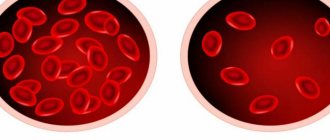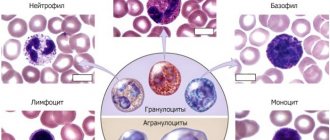Organs are made up of many different cells, which in turn contain some enzymes - their common name in the blood is transaminase. This indicator is responsible for the most important processes in the blood - transamination.
In turn, transamination is a process that moves amino groups from amino acids, delivering them to alpha-keto acid molecules, being a connecting component of carbohydrate and nitrogen metabolism.
Indicators of these processes are responsible for the normal condition of the liver. Since liver diseases show almost no symptoms, the disease is detected at advanced stages, which complicates treatment and increases its duration and costs of therapy.
Blood test for transaminase
Transaminase is the general name for enzymes found inside the cells of different organs.
When tissue is destroyed or damaged, due to injury or pathology, enzymes leave the cells, so their level in the blood increases. The content of transminase in the blood is important in diagnosis, since it is a sign of certain diseases. Particular attention in diagnostic practice is paid to two types of enzymes - AST and ALT. Their content in the blood serves as a marker of damage to the liver, heart, and pancreas (the most common cases are hepatitis, myocardial infarction, pancreatitis). Their absolute values and the ratio of AST and ALT levels make it possible to determine the affected organ, track the dynamics of the pathological process and determine the degree of damage.
The content of transaminase is determined during a biochemical study. Blood for analysis is taken from a vein. On the eve of the procedure, you should not eat fatty foods, drink alcohol, or engage in heavy physical labor, and you should also stop taking certain medications one to two weeks before the procedure in consultation with your doctor.
The full name of the enzyme is alanine aminotransferase. From the name it is clear that this protein transports the amino acid alanine. Mainly found in the liver, as well as in the cells of the heart, pancreas, kidneys, and muscles.
Normal in blood
The acceptable values are different for women and men:
- for women the norm is no higher than 32 units/liter;
- for men – less than 40 units/liter.
For children of different ages, the norms are different:
- in the first five days of life – up to 49 units/liter;
- up to six months – 56;
- from six months to a year – 54;
- from one to three years – 33;
- from three to six years – 29;
- from six to 12 – not higher than 39.
Reasons for the increase
A high level of ALT is characteristic of the following pathologies:
- cirrhosis of the liver;
- acute hepatitis (viral, alcoholic);
- acute pancreatitis;
- malignant liver tumor or metastases;
- obstructive jaundice;
- tumor disintegration;
- extensive heart attack;
- heart diseases in which destruction of heart muscle cells occurs (heart failure, myocarditis);
- burns;
- extensive traumatic muscle damage.
A slight increase is observed in the following cases:
- after heart surgery;
- with uncomplicated heart attack;
- chronic hepatitis;
- fatty hepatosis;
- mononucleosis.
In addition to pathological reasons for increased ALT levels, there are physiological ones. These include:
- great physical activity;
- taking certain medications (antibiotics, valerian, echinacea, nonsteroidal anti-inflammatory drugs, contraceptives);
- taking certain dietary supplements that negatively affect liver cells;
- a slight increase may be observed in pregnant women in the first trimester (this condition is considered normal);
- poor nutrition (presence of fast food, soda, processed foods in the diet).
This indicator is of particular importance in the diagnosis of liver diseases. A high level of ALT is a specific sign of liver pathology. Already 1-4 weeks before the onset of symptoms, an increased content of this enzyme is detected in the blood. In the case of acute liver disease, it exceeds the norm by more than five times. If a high level persists for a long time or increases in the later stages of the disease, this indicates massive destruction of liver tissue.
ALT analysis is indicated:
- when diagnosing pathologies of the liver, biliary tract, pancreas;
- to monitor the treatment of viral hepatitis;
- in the differential diagnosis of hepatic and hemolytic jaundice;
- for heart failure and other heart diseases;
- with pathologies of skeletal muscles;
- when examining donor blood.
The test is prescribed for people with the following symptoms:
- constant weakness;
- rapid onset of fatigue;
- poor appetite;
- dark urine and light feces;
- yellowness of the skin and whites of the eyes;
- bloating;
- nausea, vomiting;
- abdominal pain.
An ALT test may be prescribed for people at risk:
- had contact with a patient with hepatitis;
- suffering from diabetes mellitus;
- having excess weight;
- those suffering from alcohol addiction;
- taking medications with toxic effects;
- people with a hereditary tendency to liver disease.
How to recognize obvious symptoms?
Factors of liver damage can have a variety of causes, and are supported by a range of complex symptoms, which are complemented by an increase in the concentration of transaminases:
- Constant fatigue and weakness, which appeared unexpectedly or has been present for a long period of time,
- More obvious expression of the network of saphenous veins,
- Incessant itching of the skin, which becomes stronger at night,
- Darkening of urine, loss of color of stool,
- Lost appetite
- The skin turns yellow
- Bleeding of mucous membranes, nosebleeds,
- Nausea and vomiting.
There is an increased activity of hepatitis to transaminases. They increase the amount in the case of hepatitis A (10-15 days before the onset of icteric syndrome). With hepatitis B, AST is increased to a greater extent.
The essence of transamination
The transamination reaction is the process of transferring an amino group from an amino acid molecule to an alpha-keto acid molecule. The reaction does not produce free ammonia.
Transamination is
a link between carbohydrate and nitrogen metabolism .
It occurs with the participation of aminotransferase enzymes (transaminases). Such enzymes are named after the amino acid that takes part in a particular reaction. Transamination of alanine is possible with the participation of alanine aminotransferase (ALAT), while aspartic acid is transaminated with the help of aspartate aminotransferase (AST) in the blood.
Normal ALT and AST in adults and children
The level of aminotransferases in human blood is determined using a biochemical study. For correct results, the analysis should be performed in the morning on an empty stomach .
The norm of AlAt (ALT) and AsAt (AST) in the absence of pathological processes in the blood in women, men and children are fundamentally different:
- children under 9 years old - AlAT up to 50 U/l, AST up to 140 U/l;
- children over 9 years old - AlAT up to 50 U/l, AST up to 55 U/l.
- men - AlAt up to 45 U/l, AST up to 47 U/l;
- women - ALT and AST up to 31 U/l;
Other diseases in which the content is increased
While aspartate aminotransferase is considered a cardiac marker, alanine aminotransferase has the highest concentration in liver tissue . An increase in these indicators may indicate a number of damages in internal organs.
In various diseases, the ratio of aminotransferases to each other changes. The ratio of cardiac to hepatic marker activity is called the de Ritis ratio . With cardiac pathologies, the value of the coefficient increases, and with changes in the liver, it decreases. However, both values are higher than normal.
Enzymes, in addition to diseases of the cardiovascular system, are elevated in the following pathologies:
- Severe liver diseases - cancer, fatty hepatosis, cirrhosis.
- Mechanical jaundice.
- Hepatitis of various origins. An increase in alanine aminotransferase often occurs even before the onset of symptoms of the disease. Biochemical analysis also determines an increase in bilirubin levels. Aspartate aminotransferase is increased to a lesser extent.
- Cholestasis.
- Acute pancreatitis. The level of alanine aminotransferase increases with the appearance of an inflammatory process in the pancreas. In chronic pancreatitis, a uniform increase in both enzymes is determined.
- Muscle injuries, extensive burns.
Prevention
- Eat a balanced diet;
- Engage in moderate physical activity regularly;
- Maintain a healthy weight;
- Treat a viral infection;
- Control chronic conditions such as diabetes or autoimmune hepatitis.
Temporary increases in liver enzymes are not unusual. Often this situation can be resolved through lifestyle changes.
When a viral or chronic infection causes elevated transaminase levels, it is important to seek medical attention promptly to prevent further liver damage. Early diagnosis and treatment will help reduce the risk of complications.
When the quantity is not high, but low
A decrease in transamination enzymes is a rare case. But in some pathologies, AST can drop below 15 U/l, and ALT below 5 U/l . These indicators indicate the following violations:
- severe cirrhosis;
- liver necrosis;
- pyridoxine deficiency, for example in alcoholics;
- reduction in the number of active hepatocytes;
- uremia;
- in patients on hemodialysis.
Aminotransferases are clinically important enzymes. Their increase in the blood allows one to diagnose pathologies of internal organs even before the appearance of severe symptoms . In order to bring the indicators to ideal, no special treatment or diet is required. Transaminases return to their original levels on their own as soon as the cause of cell death is eliminated.
What are liver transaminases in a blood test?
Laboratory tests are performed to diagnose liver pathologies. One of them is biochemical blood screening. A group of indicators called liver transaminases helps to assess the condition of the organ. An increase in values indicates liver disease.
Increased activity of liver transaminases and what it is, norms for adults, significance in therapeutic strategy - we will consider in detail.
Reasons for the increase
Liver transaminases are elevated with the development of liver and cardiac pathologies. This can be very dangerous. They say:
- about the presence of hepatitis (any form);
- Reye's syndrome - hepatic encephalopathy due to aspirin use;
- steatosis;
- fibrosis;
- cirrhosis;
- cholestasis;
- tumors;
- metastases from other organs to the liver;
- Wilson's disease or hepatocerebral dystrophy (congenital disorder of copper metabolism);
- myocardial infarction (with it, liver transaminases are always persistently elevated);
- parasitic infestations, because in the course of their life, parasites secrete toxins with the destruction of hepatocytes;
- liver injuries also lead to cell necrosis.
With cholestasis, stagnation of bile leads to overstretching of liver cells, their metabolism is disrupted, and in the final chain of disorders, the cells undergo necrosis.
Fatty liver also causes the destruction of normal liver cells and their replacement with fatty ones. In cirrhosis, the cells become necrotic and are replaced by rough connective tissue. Tumors destroy not only hepatocytes, but also surrounding tissues, causing inflammation.
Toxic processes in the liver after long-term use of drugs have been proven, and an increase in transaminases occurs when using any form of the drug - both tablets and infusions are equally harmful. Among them:
- analgesics, statins, antibiotics;
- anabolic steroid;
- NSAIDs;
- Aspirin, Paracetamol, MAO inhibitors (Selegiline, Imipramine);
- hormones;
- sulfonamides;
- barbiturates;
- cytostatics, immunosuppressants;
- Iron and copper preparations also necrotize liver tissue.
So far we have been talking about persistent increases in enzymes. But there is another type of increase - periodic.
Periodic or transient increases in the activity of liver transaminases can also be caused by other extrahepatic pathologies. It can occur with acute pancreatitis, hypothyroidism, obesity, mononucleosis, muscle injuries, burns, muscular dystrophies, and bronze diabetes.
A slight increase in liver transaminases is quite common. It can be triggered by poor ecology, consumption of certain foods rich, for example, in nitrates, pesticides, and trans fats. In any case, deviation from the norm of enzymes in the form of their increase requires a visit to a doctor and a full examination. Especially when heaviness and pain in the right hypochondrium are added.
Transaminases and their purpose in the body
According to the accepted medical classification, the ending “ase” indicates that transaminases are enzymatic substances.
There are more than 2,000 different enzymes in the human body, which are classified into specific classes. Aminotransferases are groups of indicators that take part in the transport of chemical compounds from one type of molecule to another. Transaminases are responsible for the transfer of amino acids - substances without which protein-related processes in the body are impossible.
Transamination processes are mostly detected in the liver. However, the determination of liver transaminases is also advisable for a number of other diseases of the kidneys and cardiovascular system.
Liver transaminases are represented by two indicators:
- ALT, ALT is alanine aminotransferase.
- AST, AST is aspartate aminotransferase.
Prevention measures
As a preventative measure, it is necessary to reduce the load on the liver. Doctors give the following recommendations - complete abstinence from drinking alcohol, dietary nutrition, and taking hepatoprotectors. With a slight increase in ALT and AST, folk remedies using birch buds, centaury, yarrow, chamomile, St. John's wort, common tansy and other plants help.
The terms transaminitis or hypertransaminasemia are used when the levels of enzymes called transaminases are elevated. Transaminitis is not a disease, but may indicate problems that require treatment. High lipid levels or similar problems may indicate inflammation in the liver.
Transaminases in the diagnosis of diseases
Transaminases increase in adult patients and newborns during necrotic processes in the liver and heart muscle.
AST and ALT increase in various diseases, which leads to certain difficulties in making a diagnosis. AST and ALT are always assessed in conjunction with liver test results and the patient’s symptoms, which clarifies the diagnostic picture.
Informative transaminases for early diagnosis of Botkin's disease and viral hepatitis form B. AST and ALT increase 14-20 days before the onset of the clinic. Early diagnosis of viral hepatitis provides a more favorable prognosis.
Despite their general similarity, both enzyme substances are concentrated differently in internal organs, which should be taken into account when deciphering the results. So, ALT is most abundant in the liver, and AST is most abundant in the heart. When AST is higher than ALT, cardiovascular disease is suspected.
Another example of a differential diagnosis is determining the true etiology of yellowing of the skin. Against the background of viral hepatitis, many enzymes penetrate into the blood, but they are absent due to blockage of the bile ducts.
Using liver transaminases, the stage of the disease can be assumed. For example, in the early stages of the development of cirrhosis, AST and ALT increase; when approaching the latent course, they are within normal values, and in advanced cases, when massive destruction of hepatocytes occurs, the release of enzymes completely stops.
The severity of a deviation from the norm in a child or adult is determined in accordance with a certain scale:
- Moderate degree. AST and ALT increase by one and a half times. Usually the etiology is due to chronic hepatitis of viral, alcoholic origin.
- Average degree. Liver transaminases increase up to 10 times. As a rule, the cause is hepatic necrosis, ischemic liver damage.
- High degree. The level of enzyme substances is 10 or more times higher than normal values.
In the chronic form of hepatitis, AST and ALT are within normal limits or increase slightly. If trace amounts are detected, a repeat blood test is recommended.
Norm
The study of blood plasma allows us to identify AST and ALT, and subsequently the results obtained are compared with the indicators that are characteristic of a healthy person. For men, the norm for ALT is up to 45 U/l, AST – up to 47 U/l. For women, ALT is normally up to 34 U/l, AST – up to 31 U/l.
The norm is calculated differently, since it all depends on the laboratory and the diagnostic equipment used. The forms indicate reference values.
Ratio of indicators
When AST and ALT show results above normal, then it is necessary to calculate the ratio between enzyme substances.
To do this, AST is divided by ALT to obtain the de Ritis coefficient. This coefficient was named after Fernando de Ritis, who, through his research, proved that there is a certain correlation between aminotransaminases and a type of liver disease.
The following patterns have been studied and proven:
- K ≥1 means that the patient has dystrophic changes in the liver, a chronic form of hepatitis (alcoholic, drug, toxic).
- K









